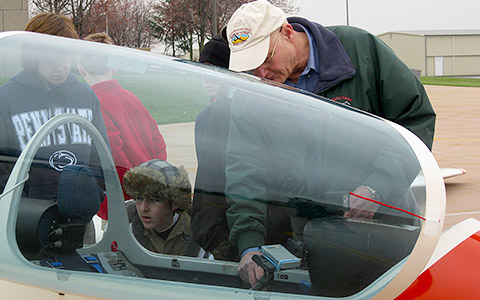
Volunteer pilots explain the parts of a Cessna 172 and how they work.
Downpours and chilly temperatures couldn’t keep Boy Scout troops from setting up camp behind AOPA’s headquarters at Frederick Municipal Airport in Frederick, Md., April 8 for an aviation camporee weekend to work toward their aviation badges. Frederick Troop 1998 hosted the event.
After pitching their tents in the rain, the scouts warmed up inside AOPA headquarters Friday night to watch movies with aviation themes. On Saturday, the scouts learned about gliders, fixed-wing piston-singles, helicopters, and jets. Sunday’s events included an opportunity to fly AOPA’s flight simulator, and the visual projection in AOPA media room allowed other scouts to critique the “pilots” performance.
 EAA Chapter 524 displays an aircraft in the building phase
EAA Chapter 524 displays an aircraft in the building phase
“The kids, they just lit up,” Janice Gilsdorf, assistant scout master for Troop 470, said of her scouts after they toured aircraft.
Each troop rotated through various stations that included an explanation of aerodynamics and glider operations by the Mid-Atlantic Soaring Association, preflight demonstrations from local pilots, a Q-and-A session about helicopters at Advanced Helicopter Concepts, building a wing rib for an RV-8 with Experimental Aircraft Association Chapter 524, a look at jets inside Landmark Aviation’s hangars, a tour of the Maryland State Police and medevac helicopter, hands-on science experiments with Kraemer Aviation Services, and flight planning at Frederick Flight Center. The Air Safety Institute showed the scouts a “Pinch Hitter” video, aimed at helping people new to aviation understand the basics of flight.

An Experimental aircraft hooked the boys' attention.
While the Frederick airport event was new to some scouts, others like Paul Haga were already familiar with the airport. “Me and my dad always get donuts from Dunkin’ Donuts and come out here” to see the Goodyear Blimp, he said.
 Harry Kraemer creates science experiments with household items to teach children the principles of flight.
Harry Kraemer creates science experiments with household items to teach children the principles of flight.
In addition to learning how aircraft fly, the scouts participated in science experiments with Harry Kraemer of Kraemer Aviation Services to understand the principles of lift and high and low pressure. Using a beaker, Kramer heats the air inside with a match and places a boiled egg on top. A vacuum is created, pulling the egg inside. To demonstrate low pressure, he pushes two suction cups together and challenges the boys to pull them apart.
It’s important, Kramer said, for the children to “see it, feel it.”
That same principle carried into EAA Chapter 524 where the scouts helped build a wing rib and see an aircraft in the process of being built.
 David Medina of the New Market Troop 4628 helps build a wing rib.
David Medina of the New Market Troop 4628 helps build a wing rib.
“We got to make an airplane part and look at one aircraft that’s not finished and a finished aircraft,” said David Medina, with New Market Troop 4628.
After just a few sessions, the scouts impressed volunteer pilots with how much information they had retained.
Members of Troop 470 quickly rattled off the four forces of flight and parts of an aircraft. Many of the students in that troop had studied aviation recently at school, making the camporee a perfect opportunity for them to reinforce that knowledge, Gilsdorf said. Gilsdorf, who became a private pilot but stopped flying after three years to pursue other interests, said she plans to take her son Colin flying with a flight instructor this spring once he overcomes his nerves. But if the camporee has the same effect on him as it has on his fellow scouts, that shouldn’t be too difficult.
“I want to fly a plane actually,” fellow scout Chris Caballero exclaimed.

Boy Scouts learn the basics of what makes a glider fly.



